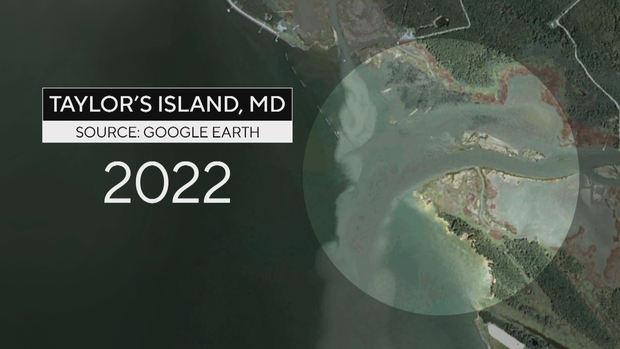Oyster Castles: Maryland's innovative defense against rising sea levels and erosion
BALTIMORE -- Dorchester County is experiencing one of the fastest sea-level rises in the country, where sea levels are projected to rise by 1.4 ft by 2050 and 4.2 ft by 2100 according to research from the Virginia Institute of Marine Science.
WJZ went to the eastern shore, scientists are searching for answers beneath the waves.
Rising sea levels are swallowing our shorelines, uprooting trees and cutting off land as more of our coast crumbles into the bay.
A resident of Taylor's Island showed WJZ what's left of her shore-front property -- which has been slowly disappearing over the decades.
"This was all filled in with marsh grasses...there's a few left," said Danuta - who declined to provide her last name. "That fell in maybe about five years ago, but this was all land."
Dorchester County is losing an average of one foot of shoreline per year.
For those who live on the outer islands, the effects of erosion and rising sea levels are getting closer to home.
This was St. Johns' creek on Taylor's Island in 2005.
This is what it looks like now.
Revetments, breakwaters and ripraps – have all been used to combat erosion. But scientists at the University of Maryland center for environmental science are researching a more advanced and sustainable approach -- oyster castles.
Matthew Gray is an assistant professor at Horn Point laboratory in Cambridge.
"As those oysters grow, they cement the structure together and you can deploy these blocks and structures in a way that buffers shorelines," said Gray.
The oysters latch on to the hollow cement blocks – creating a man-made reef.
"As the sea level rises, those oysters will grow and fill in that space," said Gray.
The idea is that they will act as a speed bump, weakening the waves as they lap against the shoreline.
"We use a variety of sensors to measure how these structures actually dampen waves," Gray said.
Stone or cement breakwaters break down over time, but oyster castles are a living breathing fortress that repairs itself.
"Figuring out how to build with oysters and integrate them could not only prolong the effectiveness of that infrastructure after sea level rise manifests itself but also could immediately improve the habitat of that gray infrastructure," said Gray.
Gray infrastructure is the man-made concrete or steel barriers that are used to prevent shoreline erosion. It makes up roughly 1,000 miles of the bay's coastline.
Our crew boarded Gray's boat to get a closer look.
"All you see is the structure but it's not breaking any waves," said Gray. "If anything, it's increasing wave height."
He said oyster castles would reinforce the existing gray infrastructure and help absorb the impact of the waves.
"These things are really living and adapting with the environment. That's why we want to build with nature," said Gray. "If the environment changes, you have to change your design."
He said oyster castles work best in an environment where the oysters can thrive. Scientists at Horn Point laboratory are experimenting where that sweet spot is.
"They all need research. Every substrate is different, and we need to understand how and when we can use them," said Gray. "The easiest place to deploy these right now is a salty bay that has a warm winter."
Protecting Maryland's roughly 3,200 miles of coastline will take time. Gray explained that currently, most projects are small in scale.
"You can't have rinky-dink projects, you have to have massive reefs that can fortify submarine bases and other things like that," said Gray.
As the threat of erosion creeps up on the people who live in Dorchester county – oyster castles could be their first line of defense.
"They recognize that a sustainable solution really needs to incorporate building with nature," said Gray.
"The Chesapeake Bay Foundation in partnership with the Maryland Department of Natural Resources and many others agencies completed 1,329 acres of oyster reefs in Maryland tributaries as of last year. These large-scale oyster restoration projects garnered international recognition and received tens of millions in funding in recent years."





